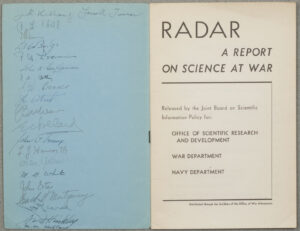Published: Washington, 1945
The Second World War is sometimes called  the “physicists’ war.” For most people, this term brings to mind J. Robert Oppenheimer’s team of Los Alamos scientists and the astonishing atomic bombings of Hiroshima and Nagasaki. Less widely understood is the importance of radar to the Allies’ victory, and the crucial contributions of the scientists of the MIT Radiation Laboratory. As some Rad Lab researchers liked to say, the atom bomb ended the war, but it was radar that won it.
the “physicists’ war.” For most people, this term brings to mind J. Robert Oppenheimer’s team of Los Alamos scientists and the astonishing atomic bombings of Hiroshima and Nagasaki. Less widely understood is the importance of radar to the Allies’ victory, and the crucial contributions of the scientists of the MIT Radiation Laboratory. As some Rad Lab researchers liked to say, the atom bomb ended the war, but it was radar that won it.
Radar, short for “RAdio Detection And Ranging,” uses radio waves to identify and measure the location of remote objects. Radar using relatively long-wavelength waves was in use by the start of the war, but shorter-wavelength radiation, in the centimeter or “microwave” range, would be much more accurate. In 1940, the so-called “Tizard mission” led by British scientist Sir Henry Tizard shared with U.S. researchers the resonant cavity magnetron, which was the first device to generate sufficiently energetic short-wavelength radiation, and an enormous technological advance.
After this boost, the Radiation Laboratory was established by the National Defense Research Committee (NDRC) at MIT. Between 1940 and 1945, the Rad Lab developed over 100 radar systems, including systems for submarine detection, gunfire control, and aid to strategic bombing. Their dazzling innovations kept the Allies’ radar technology ahead of Germany’s, and the impact of this work is hard to exaggerate.
This U.S. government pamphlet is dated August 15, 1945, the day of the announcement of Japan’s surrender. In non-technical language, it describes how radar works, its early history, its wartime development, and the importance of radar to victory on land, air, and sea. This particular copy of the pamphlet is remarkable because it belonged to James R. Killian, executive assistant to MIT President Karl Taylor Compton during World War II and MIT President from 1948 to 1959. Inside the front cover, the pamphlet is autographed by several members of the Radiation Laboratory, including Lee DuBridge and F. Wheeler Loomis. Never heard of them? DuBridge was the Rad Lab director, and Loomis was his associate director and right-hand man. Although they never reached Oppenheimer’s level of celebrity, their equally brilliant management of radar research at MIT was instrumental to the war’s outcome.
